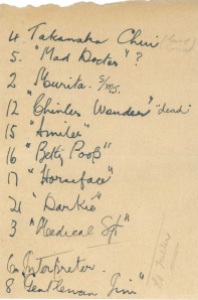After World War II came to an end in Southeast Asia, the Allies tried to bring to trial Japanese who had committed war crimes there. They were particularly concerned with identifying Japanese who had committed war crimes against Allied soldiers and prisoners of war.
In order to do this, the same kind of information that is used in other court cases had to be collected. People needed to accuse certain Japanese of crimes and supporting evidence had to be found in order to convict the accused person.
One group of people who provided a great deal of such information were Allied soldiers who had been prisoners of war in the region. Many of these men witnessed crimes committed by Japanese officers and guards in prison camps.
However, the people who attempted to collect evidence from former Allied prisoners of war soon encountered a problem – many of the Allied soldiers only knew the Japanese by nicknames that the soldiers had themselves created for the Japanese, rather than by their real names.
In other words, former prisoners of war remembered the crimes that Betty Boop, Horseface, Mad Doctor and George Formby had committed, but who exactly were these people? That had to be determined in order to bring charges against them.
So the people in charge of collecting information about war crimes distributed pictures to former prisoners of war of Japanese officers and soldiers who had served in Southeast Asia during the war in an effort to link nicknames to faces. Meanwhile, the real names of these individuals were obtained through interrogation after they had been apprehended.
I find the period immediately following World War II to be fascinating. This effort to identify people only known as Betty Boop and Horseface in order to bring them to justice is just a small example of the many challenges that people faced in trying to restore some form of order to a region that had been seriously thrown into disorder.
The above images come from the following file in the National Archives of Australia that contains information about this effort to use photographs to identify Japanese war criminals: War Crimes [Investigations – General correspondence regarding photographic recognition of suspected Japanese war criminals, requests for interviews and affidavits by former POWs held various camps in Japan, Korea, Thailand (Siam), Singapore, Java, Thailand-Burma Railway and Italy.] NAA: D844, 167/1/1A.


